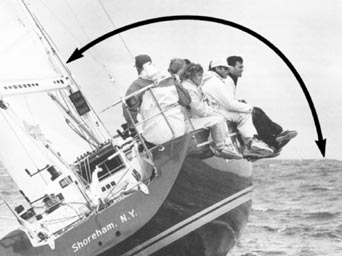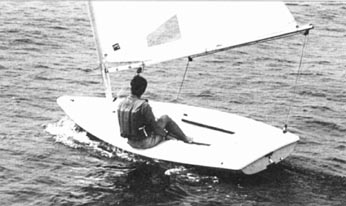A few years ago I had a chance to go iceboating for the first time. I
must admit this sport was a bit of a mystery to me. I knew a little about it from friends
who raced DNs, but I didn’t understand how anyone could sail a boat without being
able to see wind on the water.
What I learned, after two days of scooting around in Nites and Skeeters
on Wisconsin’s Lake Geneva, is that "feel" is everything. The only way to
tell how high or low you can steer is by feeling the wind pressure on the rig and the
speed of the boat going over the ice. It’s amazing how sensitive you become to these
sensations when you can’t see your "normal" clues.
In many ways, steering a boat on water is a lot like steering an
iceboat. If you want to have a fast hand on the tiller or wheel (a quick "paw"),
you need a very sensitive touch. Steering is, by definition, the technique of guiding a
boat from one point to another. It’s a fine art that requires concentration, practice
and the ability to feel the boat almost as an extension of yourself.
 |
When you’re
sailing upwind, one of the best all-around steering guides for any boat is your angle of
heel. You can judge heel angle by the way the boat feels under your feet, or by looking at
the angle the headstay makes with the horizon (above). On any day, find the heel angle
that seems to work best, and then try to keep it relatively constant as you sail up the
beat. |
Steering is really a series of continual turns, most if which are quite
small. Remember what we have said in past columns: Any time you turn your boat, it is
fastest to use a combination of rudder, crew weight and sail trim. One of the most
important guidelines for fast steering is, "Don’t oversteer." Try to keep
your boat going straight and fast by minimizing the amount of drag created by your rudder.
When you do need to turn, steer by moving your weight and adjusting sail trim as much as
possible.
Find a good "batting stance"
Steering a boat upwind has always been one of my favorite parts of
sailing. In order to do it well, you should sit or stand in a good place. Be sure you are
comfortable, so you minimize distractions and maximize your attention span. Position
yourself as high off the water, as far forward, and as far outboard as possible. This will
give you the best view of your sails, the waves ahead, and the rest of the race course.
Last summer I sailed a bit with Young America (the New York YC’s
America’s Cup challenge), and I spent a few days steering their boat Tag Heuer (the
Farr-designed AC boat that was sailed by Chris Dickson in the ‘95 Challenger Trials).
One of the best things about this boat is it has a raised platform for the helmsperson
that is quite far forward in the boat. This allows the driver to stand almost a foot off
the cockpit sole, which makes it easy to see the jib, waves, water and everything else you
need to see for fast steering.
Once you’ve settled into a good "batting stance"
you’re ready to start driving. To steer fast, you must process information from a
number of sources. Here are some of your most useful guides:
A good sense of feel. While there are many visual clues for
steering a sailboat, perhaps the most important guides are the ones you feel. These
include the amount of heel, the sensation of speed through the water and the pressure on
the helm. By tuning into these variables and remaining sensitive to how they change over
time, you will learn a lot about what your boat needs in order to steer it fast.
If you feel the boat speed up or down or heel over, for example, you
can probably head up and point a little higher. If the boat slows down or start to level
off, you need to foot for speed and maybe ask your trimmer to ease the sheets.
Telltales on the jib or genoa. One of the best visual clues for
steering upwind are the telltales along the luff of your headsail. This is where I look
most often when I’m driving. Like a lot of helmsmen, I probably depend too much on
this single source or information. But telltales are a very good indication of how close
you are sailing to the wind. By watching their motion (see diagram), I know whether I am
pinching, footing or sailing a normal upwind angle.
Remember that the telltales don’t always fly the same from top to
bottom. Often the top telltales break before the bottom ones. So if you’re steering
by the lower telltales, you may be sailing with half the upper jib luffing. Fix this by
changing your jib set-up, and/or by watching the telltales half way up the luff (if you
can see them).
Angle of heel. Buddy Melges is one of many top sailors who use the
boat’s heel angle to help them steer fast. The easiest way to keep track of heel is
by watching the angle that your forestay makes with the horizon (see earlier photo). Heel
angle is basically another way to gauge how close you are sailing to the wind; e.g. the
higher you point, the less you heel.
Instruments. If your boat is big enough to have instruments, one of
your priorities should be to develop upwind target speeds for each wind velocity, and then
post these within easy sight of the helmsperson or tactician. These numbers are invaluable
for knowing whether you should steer the boat faster or slower at any given time.
Be sure to mount your boat speed readout (and other important
instruments) on the mast or some place where it’s easy to read while looking forward.
That way you can simultaneously watch the instruments, telltales, waves and angle of heel
without having to look down.
Use a "lookout." The ability to anticipate changes in
conditions is key for steering. For example, it helps to know ahead of time if you will
have to head up for a puff or head off to punch through waves. To improve your ability in
this area, assign one of your crewmembers to watch continually for puffs, lulls, waves and
flat spots.
On small boats, this lookout often must be the skipper because the crew
may not have a very good view of the race course. On larger boats, the tactician and/or a
crewmember sitting on the rail usually keeps a lookout. Communication should include
comments like: "Two steep waves ahead," "Puff coming in 20 seconds,"
or "Do you see the starboard tacker?"
Make sure all feedback is loud enough to be heard by both the
helmsperson and sailtrimmers. Unless your helmsperson is a quiet freak, communicate
everything you
 |
| If you sail a boat with a removable
rudder, one good way to minimize oversteering is to practice sailing the boat with no
rudder. Start by sailing on a reach in lighter air; when you master that, try sailing
upwind. This will force you to steer entirely by moving your crew weight and adjusting
sail trim. It also helps you tune in to the feel of the boat, which wil make steering that
much easier when you put the rudder back on. |
see that may have any importance, even if it seems obvious.
Other boats. Especially in one-designs, steering technique depends
a lot on how you’re moving relative to other boats. When I’m driving, I like to
have one crewmember (it could be the lookout) give me continuous readouts on our speed and
height compared to our "neighbors" (especially the ones behind my back or under
the jib where I can’t see). This information feedback helps me know whether I should
steer higher or lower. If we have a speed problem, I’ll ask for feedback on what
other boats are doing. Often a slight change in sail trim or steering technique will make
a difference.
Practice and experience. Time in the boat is usually the best way
to learn how to steer fast. Get as much stick time as you can in a variety of conditions.
When you are steering, whether it’s during a race or in practice, focus 100% on
driving the boat fast. Try different things to see what works, and what doesn’t work.
Whenever you have a chance, go racing (or practicing) with another
sailor who is a very good helmsperson. Watch him or her carefully: Where is he/she
looking? What does he/she communicate to his/her sailtrimmers? etc. Invite him or her to
come sail with you during a practice session and give you a critique on your steering, By
putting in a lot of effort and keeping an open mind to learning, you’ll be doing the
most you can to develop a quick paw.
TELLTALE
GUIDES
The action of your jib telltales is a good guide for steering fast upwind.
You want the leeward telltales streaming straight back almost all the time. On the
windward side, the optimal telltale action depends on a number of factors like your speed,
wind, waves and tactical considerations. |
 |
Point
mode
Windward telltales fly nearly straight up most of the time. Steer in this mode when:
• You have moderate wind and smooth water;
• You need good height for a short period of time; or
• It’s windy and you must feather to depower. |
Normal mode
Windward telltales lift at a 45° angle much of the time. Steer in this mode when you need
a good all-around heading to maximize VMG upwind. If possible, use telltales that are half
way up your sail and at least 8 inches or so aft of the luff. |
Speed mode
Both windward and leeward telltales stream aft. Steer in this mode when:
• You are racing in waves and/or very light air;
• You need to accelerate. By putting the bow down, you “press” on the sails
for a speed build. |
David Dellenbaugh, former starting helmsman for America3, publishes Speed&Smarts, a
monthly newsletter of how-to information for racing sailors. For subscription information
call: 800-356-2200.Or by email: 71020.3237 @compuserve.com. •


